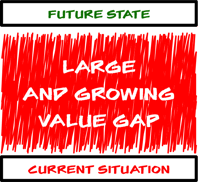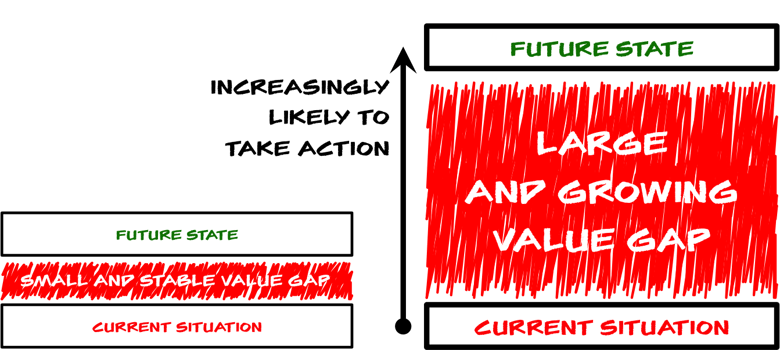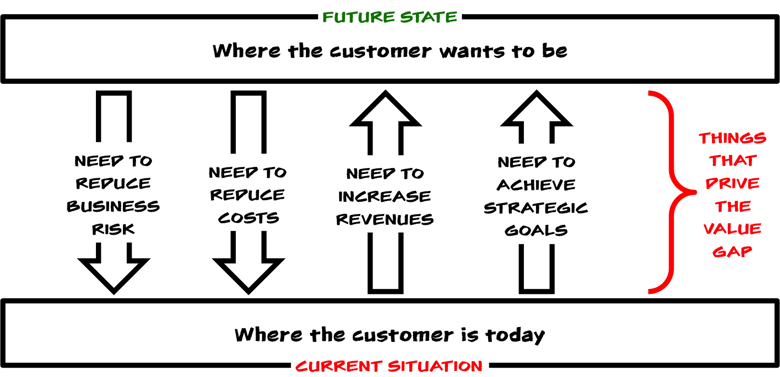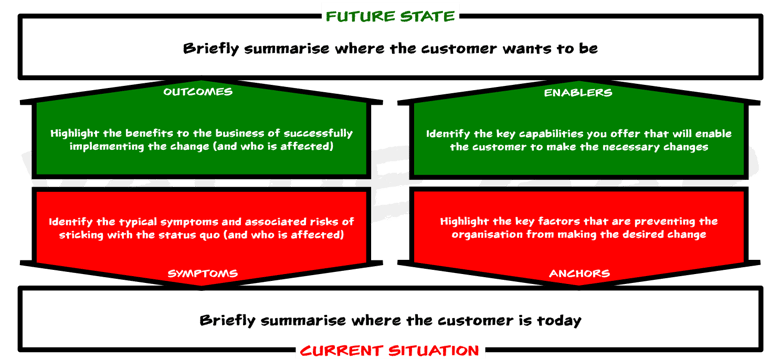 One of the key principles of value selling is that unless and until our customer acknowledges a problem that requires action, there have no need to invest in a solution and there can be no potential sale.
One of the key principles of value selling is that unless and until our customer acknowledges a problem that requires action, there have no need to invest in a solution and there can be no potential sale.
But not all problems are equal. The issue could be trivial, significant or critical. The value gap between the prospect’s current situation and their desired future state could be insignificant or so large that action is inevitable.
It’s down to our sales people to help our customer to acknowledge the value gap and either amplify it to the point where they conclude that they simply have to do something or – if we can’t – to accept that they will probably decide to stick with the status quo.
But how can we best guide our customer in first acknowledging and then amplifying the gap between where they are today and where they need to be in the future? In collaboration with our clients, we’ve developed a simple visual tool that I hope you might also find useful…
Let’s first acknowledge that the size and nature of the value gap is a powerful indicator of the likelihood of action. Small and stable value gaps are much less likely to drive action than large and growing value gaps.

HIGH LEVEL DRIVERS
There are four high-level factors that can drive the value gap: the need to reduce business risk, the need to reduce costs, the need to increase revenues and/or the need to achieve certain strategic goals. If none of these are at play, the need to change is likely to be weak.

VISUALISING THE VALUE GAP
So how can we help our customers to not only recognise the compelling need for change, but also guide them to the conclusion that our approach is the one most likely to enable them to achieve their desired future state?
Our visual approach to defining the value gap involves six interlocking elements:

The first two elements of the value gap – the “bread in the sandwich” – are their current situation and their desired future state. We need to help them to simply and succinctly articulate:
[1] THEIR CURRENT SITUATION: briefly summarise where the prospect is today, including the most obvious negative consequences associated with sticking with the status quo
[2] THEIR DESIRED FUTURE STATE: briefly summarise what the prospect has decided they need to achieve, including the key positive outcomes that they can expect from making the change
Then we need to progressively work through the key components of the value gap – the “meat in the sandwich”:
[3] KEY SYMPTOMS: What are the typical symptoms, risks and consequences of the prospect choosing to stick with the status quo?
[4] SIGNIFICANT ANCHORS: What are the constraints or impediments that are stopping or could stop them from making the necessary changes?
[5] KEY ENABLERS: What key capabilities can we offer that will allow the prospect to eliminate the anchors and achieve their desired future state?
[6] SIGNIFICANT OUTCOMES: What are the significant benefits that the prospect can expect to achieve as a result of achieving their desired future state?
There’s a loose sequence in which these elements are best established indicated by the numbers above, but developing the value gap tends to be an iterative process that cycles around the various elements until a coherent picture emerges.
Summarising the entire value gap in a single slide can be a tremendously powerful way of helping your customer to clearly visualise the reason to take action – and why they should adopt your approach to achieving the necessary change – supported, of course, by greater detail where necessary.
I’ve found this approach tremendously powerful in qualifying opportunities, accelerating the progress of deals and reducing the risk that the prospect will at the need of the day decide to “do nothing”.
The approach is probably overkill in simple transactional sales, but in any complex B2B sales situation involving multiple stakeholders and conflicting priorities, the time required to do this – less than you would think, once your sales people become practised at it – is more than justified in terms of improved performance.
By the way, we’ve developed a bunch of customer-validated questions that help sales people to explore and develop each of the six elements. Drop me a line if you’d like to learn more about this or any other aspect of Value Selling.
Have you had any similar experiences of using “value gap” thinking to increase sales effectiveness?



